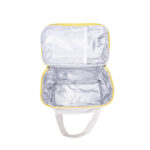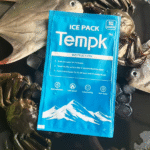Packs de glace sèche pour aliments surgelés: Le guide ultime de l'expédition sûre et efficace
L'expédition de produits surgelés exige une attention méticuleuse aux détails pour garantir que les produits restent congelés et intacts tout au long du processus de livraison.. Les blocs de glace carbonique sont largement considérés comme la meilleure solution pour conserver les aliments surgelés à la bonne température., empêcher le dégel, détérioration, et maintenir la qualité des aliments. Dans ce guide complet, nous allons explorer le fonctionnement des packs de glace carbonique, la bonne manipulation des expéditions de produits surgelés, et les dernières tendances en matière de logistique sous chaîne du froid pour 2025.
-
Pourquoi des packs de glace carbonique indispensables pour l'expédition d'aliments surgelés?
-
Comment déterminer la quantité correcte de neige carbonique pour votre envoi?
-
Quelles sont les principales pratiques d'utilisation de la neige carbonique pour conserver les aliments surgelés?
-
Comment les packs de glace carbonique se comparent-ils aux autres méthodes de refroidissement comme les packs de glace ou de gel ordinaires?
Pourquoi les packs de glace sèche sont-ils essentiels pour l'expédition d'aliments surgelés?
Glace sèche, ou dioxyde de carbone solide (Co₂), est l'agent de refroidissement préféré pour l'expédition d'aliments surgelés. Contrairement à la glace ordinaire, la glace carbonique reste à une température beaucoup plus basse, -78.5°C (-109.3°F), ce qui est essentiel pour maintenir l’intégrité des produits surgelés comme les fruits de mer, viande, glace, et autres denrées périssables.
Principaux avantages de la glace carbonique pour l'expédition d'aliments surgelés:
-
Température extrêmement basse: La glace carbonique fournit une, froid de longue durée, crucial pour les aliments surgelés qui doivent rester en dessous de -18°C (0°F) pendant le transport.
-
Pas de résidu d'eau: Contrairement à la glace ordinaire, qui fond et crée de l'eau, La glace sèche sublime directement dans le gaz, ne laissant aucune humidité qui pourrait endommager les emballages alimentaires.
-
Durée de refroidissement plus longue: La glace carbonique dure beaucoup plus longtemps que la glace traditionnelle, Le rendre idéal pour les expéditions longues, surtout ceux qui nécessitent 24-72 délais de livraison en heures.
Comment les packs de glace carbonique se comparent-ils à la glace ordinaire?
En comparant la glace carbonique à la glace traditionnelle, la neige carbonique se distingue par sa capacité à maintenir des températures inférieures à zéro sans risque de dégâts d'eau.
| Fonctionnalité | Glace sèche | Glace ordinaire |
|---|---|---|
| Plage de température | -78.5°C (-109.3°F) | 0°C (32°F) |
| Durée de refroidissement | 24–72 heures | Généralement 12 à 24 heures |
| Processus de sublimation | Se transforme en gaz (pas de liquide) | Fond dans l'eau |
| Idéal pour | Aliments surgelés, médicaments | Refroidissement à court terme |
| Exigence de manipulation | Matières dangereuses (étiquetage requis) | Sans danger (aucune manipulation particulière n'est requise) |
Comment choisir la bonne quantité de neige carbonique pour votre envoi
La quantité de neige carbonique nécessaire pour expédier des aliments surgelés dépend de plusieurs facteurs., y compris la durée de l’envoi, le type de produit expédié, et la température ambiante pendant le transport. Vous trouverez ci-dessous des directives générales pour déterminer la quantité de neige carbonique:
-
Pour les expéditions 24h / 24: Utiliser 5-10 livres de glace carbonique par période de 24 heures.
-
Pour les expéditions de 48 heures: Utiliser 10-20 livres de glace carbonique.
-
Pour les expéditions de 72 heures: 20-30 des livres de glace carbonique sont généralement nécessaires.
Assurez-vous de tenir compte des fluctuations de température et des retards en ajoutant un 20-30% tampon pour votre calcul de glace carbonique.
Comment emballer des aliments surgelés avec de la glace sèche?
Un emballage approprié est essentiel pour garantir que la glace carbonique reste efficace tout au long du processus d'expédition.. Voici quelques bonnes pratiques pour emballer des aliments surgelés avec de la neige carbonique:
Meilleures pratiques pour emballer les aliments surgelés:
-
Utiliser des conteneurs isolés: Choisissez des conteneurs aux propriétés isolantes élevées pour minimiser le transfert de chaleur. Des matériaux comme de la mousse ou des panneaux isolés sous vide (Vips) sont idéaux.
-
Superposez correctement la glace carbonique: Placez de la neige carbonique au fond du récipient, avec les aliments surgelés placés au-dessus. Cette configuration garantit que les aliments restent froids par le bas.
-
Assurer une bonne ventilation: Depuis la glace sèche sublime dans le gaz, il est crucial de permettre au gaz de s'échapper. Utilisez des couvercles ventilés ou percez de petits trous dans le récipient pour éviter l'accumulation de pression..
-
Sceller correctement: Utilisez du ruban adhésif d'emballage solide, mais évitez de sceller complètement le récipient pour garantir que le gaz puisse s'échapper et éviter les accidents..
Pour la pointe: Vérifiez toujours que votre emballage est hermétique pour garantir qu'aucune source de chaleur externe ne puisse compromettre la chaîne du froid..
Précautions clés lors de la manipulation de glace sèche
La manipulation de glace carbonique nécessite quelques précautions de sécurité de base pour éviter les accidents:
-
Portez des gants isolés: La glace carbonique est extrêmement froide et peut provoquer de graves engelures. Utilisez toujours des gants isolants épais lorsque vous manipulez de la neige carbonique.
-
Assurer une bonne ventilation: Pour éviter l’accumulation de dioxyde de carbone, assurez-vous que votre conteneur d'expédition dispose d'une ventilation adéquate.
-
Étiqueter correctement les envois: La neige carbonique est considérée comme une matière dangereuse. Assurez-vous que votre envoi porte clairement l'identifiant UN1845 et « Dioxyde de carbone, Marquages "solides" pour respecter la réglementation.
Meilleures pratiques d'utilisation de la glace carbonique pour l'expédition d'aliments surgelés
Pour obtenir les meilleurs résultats lors de l’expédition d’aliments surgelés avec de la neige carbonique, suivez ces conseils:
-
Planifier à l'avance: Calculez la quantité requise de glace sèche, en tenant compte du temps de transit et du type de produit.
-
Utiliser des appareils de surveillance de la température: Ces appareils aideront à suivre la température pendant le transport pour garantir que vos aliments surgelés restent à la bonne température..
-
Travaillez avec des partenaires d'expédition expérimentés: Choisissez des transporteurs expérimentés dans la manipulation de produits sensibles à la température pour garantir une livraison rapide et sûre..
Tendances et développements dans le transport de glace carbonique pour les aliments surgelés (2025)
Alors que la demande d’aliments surgelés continue d’augmenter, le secteur de la logistique de la chaîne du froid évolue. Voici quelques-uns des développements clés pour 2025:
2025 Tendances de l'expédition de la glace sèche:
-
Emballage intelligent: La technologie d'emballage qui intègre des capteurs IoT permet une surveillance de la température en temps réel, réduire le risque de détérioration.
-
Options de glace carbonique respectueuses de l'environnement: Les entreprises explorent des solutions durables de glace carbonique qui réduisent l’impact environnemental, comme la neige carbonique dérivée de sources renouvelables.
-
Isolation améliorée: Les progrès des matériaux isolants contribuent à prolonger l’effet de refroidissement, réduisant le besoin de grandes quantités de neige carbonique.
Insistance au marché:
La demande croissante de produits surgelés, motivé par le commerce électronique et les préférences des consommateurs pour plus de commodité, conduit les entreprises de logistique à investir dans des méthodes d'expédition plus efficaces. En intégrant des technologies avancées et des solutions respectueuses de l'environnement, l'industrie s'efforce de répondre à la demande croissante d'expéditions de produits surgelés sûres et fiables.
Questions fréquemment posées
Q1: De quelle quantité de neige carbonique ai-je besoin pour expédier des aliments surgelés?
Pour chacun 5 livres de nourriture surgelée, utiliser 1-2 livres de glace carbonique pour les courts trajets. Pour les expéditions 24h / 24, utiliser 5-10 lbs par 10-15 livres de nourriture surgelée. Ajoutez toujours un tampon de 20-30% pour la sécurité.
Q2: La glace carbonique peut-elle être utilisée pour expédier des fruits de mer?
Oui, la glace carbonique est parfaite pour expédier des fruits de mer car elle aide à maintenir la basse température requise, éviter la détérioration et garantir que le produit arrive en excellent état.
Conclusion et recommandations
Les packs de glace carbonique sont la meilleure solution pour expédier des aliments surgelés, offrant un refroidissement constant sans les inconvénients de la glace traditionnelle. En comprenant la quantité appropriée de neige carbonique à utiliser, choisir le bon emballage, et en respectant les règles de sécurité, vous pouvez vous assurer que vos expéditions de produits surgelés arrivent en toute sécurité et à temps.
Étapes suivantes: Prêt à améliorer l'expédition de vos aliments surgelés? Contactez-nous dès aujourd'hui pour en savoir plus sur la manière dont nos solutions de glace carbonique peuvent optimiser votre logistique de chaîne du froid..
À propos du tempk
Le tempk est un leader des solutions logistiques de la chaîne du froid, proposer des kits d'expédition avancés, systèmes de surveillance de la température, et des emballages spécialisés pour assurer le transport en toute sécurité des denrées périssables. Grâce à notre vaste expertise dans le transport de produits surgelés, nous fournissons des solutions personnalisées pour répondre à vos besoins.
Appel à l'action: Contactez Tempk pour obtenir des conseils personnalisés sur vos besoins en matière d'expédition de produits surgelés et découvrez comment nous pouvons vous aider à rationaliser vos opérations de chaîne du froid..























